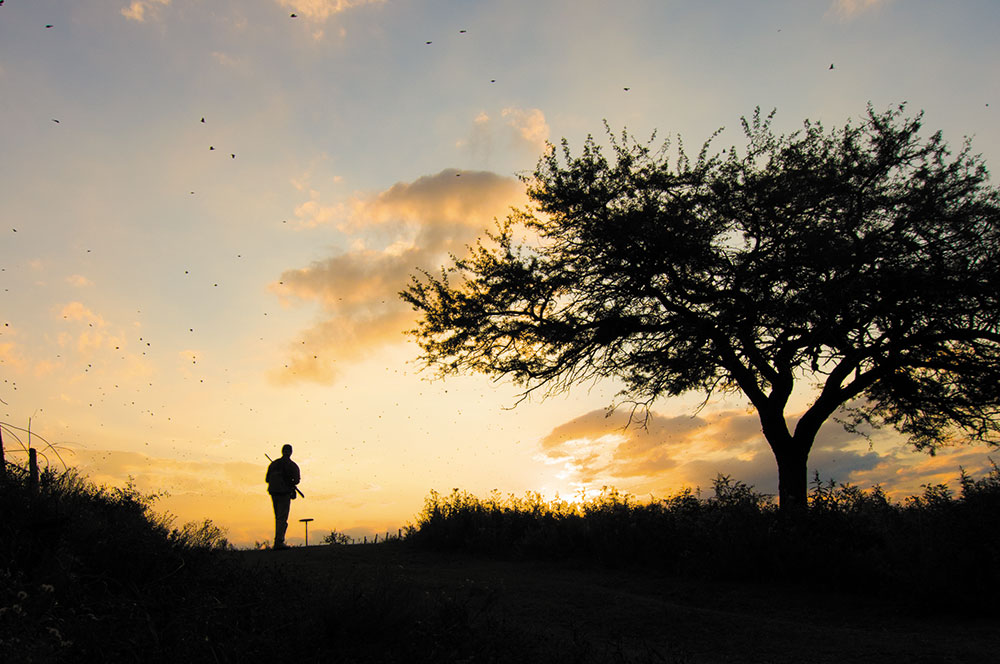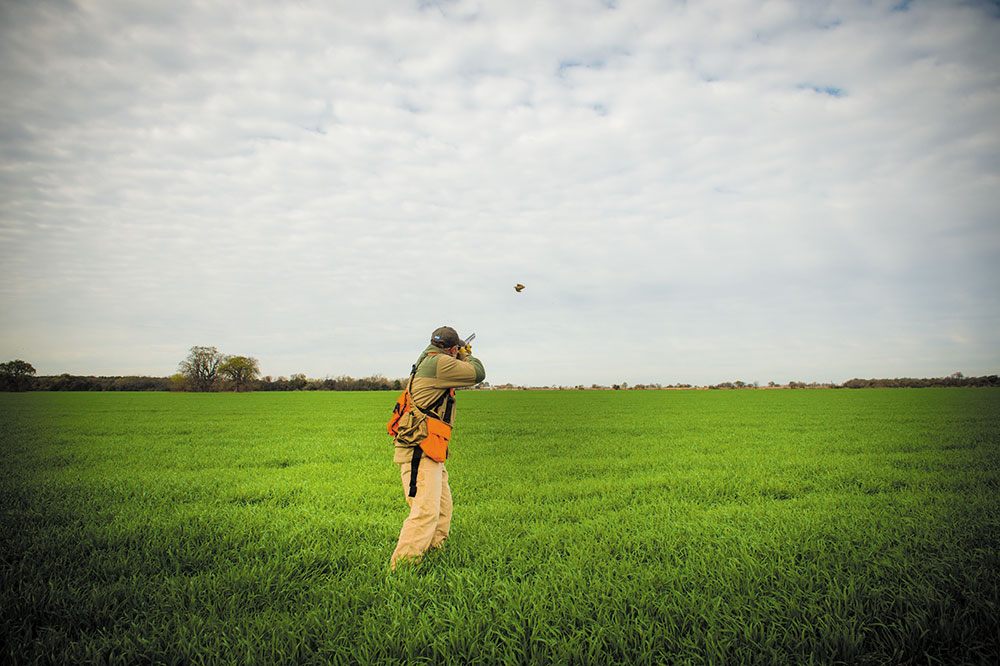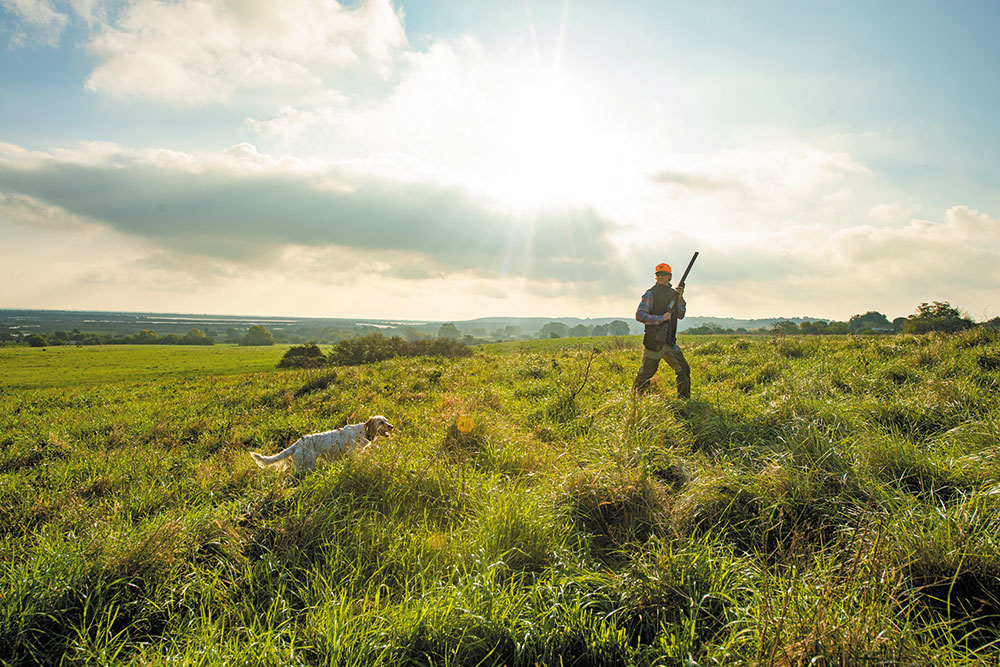Perdiz in the Pampas

In the minds of most wingshooters, Argentina equates to doves—not just a few doves, but millions and millions of them darkening the sky and presenting as targets until your barrels are too hot to touch and your shoulder is so badly bruised that it is starting to show on your back. While dove hunting is big business these days in Argentina and elaborate luxury lodges cater to mostly American and European hunting tourists, a majority of Argentinians don’t bother shooting the ubiquitous doves.
Their passion is the pursuit of a far less common and vastly more challenging native upland gamebird that is unique to the Pampas grasslands of Argentina, Southern Brazil, Paraguay, and Uruguay. Nothura maculosa, commonly known to ornithologists as the spotted nothura, is a species of tinamou bird. It is a distant cousin of the ostrich and emu, but closer in size and behavior to the Eurasian partridge, despite being unrelated genetically. Whatever one wishes to call the bird, in South America it bears just one name: perdiz.
The perdiz is the king of gamebirds in South America, known for its extraordinary camouflage among the dense native grasses of the Pampas, its cunning ability to elude dogs and guns alike, and its breathtakingly fast flush and flight from cover. While their range extends from Southern Brazil and Paraguay into much of Northeastern Argentina and across Uruguay, some of the best concentrations of perdiz are found in the bottomlands of Argentina’s Entre Ríos Province.
Entre Ríos—meaning “between the rivers” in Spanish—is just that, a province sandwiched between the Paraná River Delta to the west and the Uruguay River to the east, where Argentina meets the small, but beautiful neighboring nation of Uruguay. This region is the heart of the great plains, or the Pampas, of the South American continent. This is gaucho country, and the vast herds of cattle and sheep are still moved across the Pampas on horseback by hardened men with leathery skin, wise faces, and wide, wool berets in place of cowboy hats. This is a hard, but honest life of horses, saddles, cattle, and campfires. It is here that the origins of the world-famous asado, or Argentine barbecue of ribeyes and skirt steaks—cooked outdoors over the glowing orange coals of a wood fire and served with chimichurri—has its roots. These traditions from the late 1800s are largely unchanged today.

From 1860 to 1930, Argentina was booming based on the early agricultural development of this region for farming and grazing livestock. A global beef market was forming, and the agrarian economy was thriving, briefly making Argentina one of the world’s 10 richest nations. Nearby Buenos Aires was a burgeoning cosmopolitan metropolis, and the Entre Ríos countryside became dotted with estancias, the lavish ranch houses of the aristocracy on their vast landholdings of horse and cattle pastures that sprawled across the Pampas.
In more recent decades, the government’s socialist leanings, a series of sovereign bond defaults, and several currency crises have destroyed much of Argentina’s historic wealth. Some of the grandest old mansions in Buenos Aires are now boarded up, awaiting a recovery that never seems to come, and slums radiate outside the old city center, which is still a lovely mix of specialty shops, vibrant cafés, historic churches, parks, hotels, and office buildings. But in the Argentine countryside, there is a different dynamic. Many of the beautiful old estancias abandoned by a disappearing aristocracy have been transformed into private hunting lodges.
This was the case at Estancia Santa Rosa, our lodge outside of Gualeguay in Entre Ríos, which was built about 100 years ago. After early success with cattle, it became the center of a huge stud farm for prized racehorses in the 1930s and ’40s and thrived for decades, but it was all but abandoned in the last major Argentine recession. The estancia remains frozen in time with its architecture and furnishings from an earlier era. The handcrafted furniture was artisan-made but is now showing its age after generations of use. But the earthy-orange, terra-cotta tile floors, high ceilings, and grand windows display its Spanish architectural roots and aristocratic past. The gorgeous old hearth and fireplace glowed with a warming hardwood fire and begged us all to pour a cocktail and take a seat.
Each morning’s hunt was for ducks from makeshift blinds consisting of a couple stools and bamboo cuttings shoved into the deep mud and set at the water’s edge. Baiting with corn is still widely practiced in Argentina so flock after flock would come into the small spreads of decoys all morning long. With liberal limits of 20 ducks per day, there was no lack of shooting, and a heavy strap of the highly prized, rosy-billed pochard was all but guaranteed.

Everything had been going well except for one tumble into the deep mud with the Beretta I was carrying, when I waded out into the delta to retrieve the last of my 20-duck limit just 30 yards in front of the blind in about 3 feet of water. Suddenly, I was told in no uncertain terms, “No! No! BACK!” Julio, our guide, had apparently returned unannounced and seemed quite concerned for my safety as he used up two of his five English words to get me out of the water. I was shocked. I had been retrieving all morning in those waters without issue while our guide was nowhere to be found, since the first three ducks we shot at first light had mysteriously disappeared on us. I did not want to lose any more birds, so I had decided to retrieve them myself. What was he so concerned about?
Only as we loaded our strap of 40 ducks onto the tailgate of his truck, did we see the distinctive skeleton of a 12-inch piranha on the muddy shore by our feet. Julio just walked up and returning to a mix of Spanish and onomatopoeia said, “Piraña, piraña, ARRR-ARRR-ARRR!” as he impersonated a piranha eating my arm with his thumb and fingers. Only a pair of naïve gringos would not know that piranhas are not restricted to Brazil’s Amazon Basin but are found in most South American river systems, including the Paraná Delta that we were hunting. Now I know why they don’t use dogs to retrieve ducks in Argentina.
They do, however, have gun dogs in Argentina. It is just that they are reserved for a more revered quarry safely distant from the piranha-infested waters—perdiz. In fact, Julio, our elderly guide originally from Uruguay, has been breeding and training his own line of gun dogs for years. Long ago, he crossed the only two pointing dogs he had, an English setter and a Brittany spaniel. The result was a diminutive gun dog about the size of a Brittany, but with coat and coloration more like an English setter. His current dog from this hybrid line, Ñato, just fathered another litter with a small Brittany in the kennels behind the estancia. The puppies were adorable, but this unusual hybrid surprised us, and we did not know what to expect in the field.
My hunting companion, South Dakotan Quenton McEntee, and I regularly enjoyed good bird dogs back home. His South Dakota-bred Labrador retrievers are some of the finest wild pheasant and prairie-grouse flushers that one can find. My pudelpointer was bred on the eastern slope of the Sierra Nevada Mountains in California, and he points wild chukar on high ridgetops in Nevada and retrieves teal in the brackish waters of California’s coastal Suisun Marsh. We both simply love good dog work, but having hunted around the world before, we know not to always expect it. But this unusual hybrid dog, which we called the “Brittany setter,” delivered the goods—and the perdiz.

The grass in the Argentine Pampas is not like anything we had seen before. It seems to branch in every direction and tangle together, creating a springy mat about a foot deep—perfect for hiding a small, exquisitely camouflaged bird like the perdiz. We were in a large horse pasture well outside the town of Gualeguay with acres upon acres of native grass that had never been plowed or cultivated. The borders were formed by thickets of scrubby dwarf trees that were covered in frightening thorns over 2 inches in length, creating a scene that looked vaguely reminiscent of the African savanna or the edges of the Australian outback. As we walked along in this unusual grass, Julio handled Ñato, who worked just 20 yards in front of us. His eager, tireless, and persistent style reminded me of a Brittany searching the Flint Hills of Kansas for prairie chickens or the rolling plains of Montana for Huns and sharptails. But as he got birdy, it was suddenly all English setter.
His quick pace transformed into a much slower, methodical gait, his nose tipped up to scent the breeze, and he barely advanced at all through the grass. Once he had precisely determined the source of the bird scent, more than 15 yards in front of his nose, he froze into a beautiful point like a miniature English setter—only his flowing, feathered tail was low, not high—straight out behind him like the old lithographs of setters from the 19th Century, before AKC judges fell in love with high tails on all pointing breeds. Then another antiquated characteristic of the breed caught my eye. As Quenton and I approached to flush the pointed bird, Ñato set. Many American upland hunters have never seen a gun dog do this, but the English setter was originally bred to hunt birds and small game long before the invention of modern firearms. Their very name “setter” is a reference to the dog having been bred to set, or lie down flat, on the ground just after they point in order to stay out of the way of the nets that were traditionally thrown over birds by hunters before the invention of breech-loading shotguns. It was a beautiful sight to behold, some last vestige of an almost entirely forgotten era of hunting with bird dogs before they became gun dogs.
Our first perdiz, seeing the dog set and our boots close in, busted out of the grass at unbelievable speed. Never in my life have I seen a gamebird take wing that fast. The acceleration was just phenomenal. Departing the grass just 10 yards away, it was at full-flight speed and almost out of range before I could shoulder my Beretta over-and-under. Quenton had the better angle and after decades of hunting and guiding in South Dakota for wild pheasants and prairie grouse, his snapshot from a Benelli connected and his first perdiz fell, already 60 yards distant. As Ñato headed out to find the fallen bird, we marveled at the speed of the flush and the challenge that these South American gamebirds pose to the shooter. While a band-tailed pigeon or a canvasback duck might fly faster, you can see them coming from a considerable distance. The aerial acrobatics of a decoying teal or a corkscrewing snipe might offer a more technical shot. But the sheer acceleration and direct, fast departure of the perdiz surely offers one of wingshooting’s greatest challenges anywhere on Earth.

Immediately after retrieving our first perdiz, Ñato was birdy again. This time there were two or three perdiz in the grass, and with confidence in their numbers they refused to hold for the dog. He worked hard, constantly repositioning, pausing then shifting, then moving up again on one bird, then another. We focused on avoiding the spike-like thorns of the scattered small trees as we tried to keep up with the dog. Perdiz, like wild pheasants in the Dakotas, are famous for their willingness to run even when carefully pressured by a good pointing dog. These birds had bought themselves another 25 yards on the ground in a matter of seconds. One shot out of the grass behind us unexpectedly and was out of range before Quenton or I could turn. Another flushed like lightning directly in front of me and straight away. Despite what should have been an easy shot on a bird flying straight away from me, it took both barrels to drop it at what had gone from close range to considerable distance in a split second. Julio, sensing a brief break in the nonstop action, gave us a huge smile and used up another two of his five English words, “GOOOD CHOOOTING!”
Evidently, most visiting hunters from the North American continent do just fine with high-volume doves or even decoying ducks, but find perdiz baffling and almost impossible to hit. Julio, who has spent many decades guiding foreign hunters in his native Uruguay and more recently in his adopted home across the river in Entre Ríos, Argentina, was very pleased to be afield with a pair of experienced guns who had both hit the first perdiz they had even seen fly. Better yet, he was happier still to see his beloved bird dog get rewarded with two retrieves for his first two points. Unfortunately, our beginners’ luck had ended.
The next bird to flush from cover came unexpectedly from beneath my feet and was gone before I regained my balance. Another came up behind us, again on a wild flush. This time Quenton turned fast enough to shoot but could not quite close the angle on a bird of such speed. Humble again, we closed ranks behind the dog and let him get back to a more careful search for our next perdiz.

There was a break in the action long enough to enjoy the gorgeous scenery of the Argentine Pampas as we walked behind the dog. In the distance, a group of rheas could be seen feeding. Rheas are gigantic flightless birds native to South America that are very similar in size and appearance to the African ostrich or the Australian emu. Today they are protected, but for generations were hunted for their prized red meat. They would pursue them at a full gallop on horseback throwing a bola—three rocks connected with braided leather cords—to entangle their legs. I pondered which technique was more difficult: hunting rheas with a horse and bola or perdiz with a dog and shotgun?
Then Ñato locked up on point again. However, this time as I approached, he did not set. Confused, I came in a little closer to his staunch point. A lone perdiz had miscalculated its escape and was frozen not 4 inches from his nose. Even standing above it with its exact location clearly indicated by the dog, it took me several seconds to see it due to the extraordinary camouflage of its spotted brown feathers against the identically colored tangle of matted grass. In an instant, it was gone. Bravely flushing between me and the dog’s nose straight up past my face, I had no chance at a shot. Quenton was further back, though, and he swung smoothly on the highest flight we saw that day and folded the unusually high perdiz with a single report from his Benelli.
As the afternoon turned to early evening on a warm, clear winter’s day in Entre Ríos, the explosive flushes and fast flights continued. In the end, we had eight perdiz in the bag having shot four apiece, just right for dinner that night back at Estancia Santa Rosa. We soon discovered that the locals’ obsession with perdiz was not only for the excellent sport they provide to the shooter over pointing dogs, but also because their tender, white breasts, with no keel bone to hinder a knife, are delectable on the table.
The most traditional preparation of perdiz in Argentina is escabeche, a slightly sour, vinegar-based marinade with olive oil, garlic, onions, and saffron. Its roots are from ancient Persia, and it came to Spain centuries ago with the Arabs during the Moorish conquest; it outlasted the Moors and traveled with the conquistadors all the way to Latin America. In Spain today, it is the favored preparation of their chukar-like, red-legged partridge, the perdiz roja. But I would argue that this ancient recipe has achieved its pinnacle in the Pampas of South America with Argentina’s perdiz escabeche.

As we settled in after a fabulous dinner in front of the old fireplace for one last glass of Mendoza Malbec and a few wild duck empanadas to snack on, conversation flowed easily from doves to ducks to perdiz. The upland gamebird and waterfowl numbers in Argentina today are like nothing left on any other continent. Doves fly all day in unimaginable numbers, and the waterfowl limits harken back to an era long gone in North America. I worry a bit about the parallels to the destruction of some of North America’s early game abundance. The disappearance of our continent’s once ubiquitous passenger pigeon and Carolina parakeet probably tell a cautionary tale about the current unlimited shooting of Argentina’s eared doves and monk parakeets, both considered agricultural pests, not gamebirds. They are neither respected nor valued. And duck limits were once 20 birds a day in America, too.
That said, the reverence that Argentinian hunters show their perdiz, with a strictly enforced eight-bird bag limit to help maintain their numbers in the wild, gives me great hope that the unique wingshooting opportunities in Argentina today can be maintained well into the future with proper conservation. The hopeful thought of perdiz blasting out of cover in front of pointing dogs for generations to come is my lasting impression of Entre Ríos, Argentina.
Originally published in Volume 9, Number 3 (April-May 2021) of Covey Rise.
























